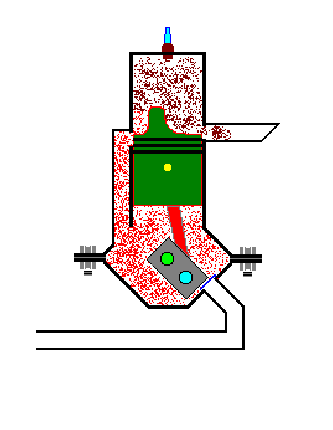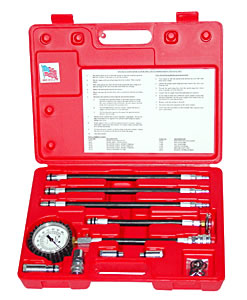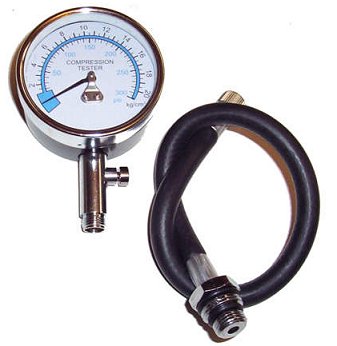| What's Hot! | Products/ Tools | EFI Tuning | Basic Tuning | Advanced Tuning | Chassis Tuning | Advertise with us |
Compression Testing
As a technician, I am frequently asked questions related to Engine Compression. My responses have been formulated below and will help any mechanic, (D.I.Y. or professional) to fully comprehend the importance of compression. The information below will guide you through a basic compression test and diagnostic routine.
For your own safety, it is advised that you purchase and follow the correct auto repair literature before attempting this process. The following text only describes general information and is not vehicle specific. This text does not express or imply any vehicle specific directions.
Q. What is compression in an engine, and how does it work?
A. Compression is a process in which air or an air/fuel mixture is confined and pressed into a smaller volume within the area of an engine's cylinder. This process forces all of the molecules to be "pressed" together under high pressure.
In the case of a gasoline engine, moderate compression is required, 140 to 160 pounds per square inch (psi). Some engines may require as much as 220 psi depending on their size and application; the manufacturer gives specific compression specifications. If the compression in a gasoline engine is too high, it can cause a problem known as preignition or detonation. This can be very destructive, causing damage to the internal parts of the engine. However, a diesel engine requires very high compression, usually 350 psi or more because it relies on this compression process to ignite the diesel oil. Diesel engines are much heavier and louder compared to the gasoline engine. This compression process, combined with an air/fuel mixture and a source of ignition, is what produces the necessary power to operate vehicles of all types.
Q. When should the compression be checked on a vehicle?
A. Generally speaking, the compression should be checked in any instance when an engine is running roughly or is lacking power. Most manufacturers and technicians believe it is important to perform a compression test every time a tune-up is done as part of preventative maintenance; consult your vehicle owner's manual for tune-up intervals. By performing a compression test, internal engine malfunctions, such as bad valves, piston rings or excessive carbon buildup, can be detected before they cause irreparable damage. It benefits the owner to be aware of these problems so they can make an informed decision whether to invest in repairs or sell the vehicle.
Compression test kits can be found online at great prices:
Q. How is the engine compression checked?
A. Engine compression is checked in different ways for different vehicles. In this section, I will only cover the general information required for testing a gasoline engine. Diesel engines require specialized equipment and will not be covered here.
Compression on a gasoline engine can be tested in two ways. The first method involves using a manual, handheld compression gauge.
* Make sure the engine has been warmed up before beginning the test, to ensure that the oil has been warmed up. A cold engine will not test correctly.
* Disable the ignition module or coil.
* Insert the compression tester into one cylinder spark plug hole at a time.
* Hold the throttle to full open position to ensure the engine gets adequate air intake.
* Crank the engine continually for at least five to 10 full revolutions to obtain an accurate reading on the compression tester.
* Record the reading for each cylinder. If any of them vary 10 percent or more from each other a problem may exist in one or more cylinders. If the variance is greater than 10 percent, specialized testing equipment may be required to fully diagnose the problem.
* If all cylinder readings are within 10 percent of each other, no further testing is required and compression is considered optimal.
The second method of testing involves the use of an electronic engine analyzer. The analyzer 'shorts' one cylinder at a time with the engine running and calculates the rpm drop. Once all cylinders are measured, a reading is given that will show which cylinders are working the hardest (have the most compression) and which are working the least (have the least compression). For the do-it-yourselfers, the easiest method is the manual compression test.
Q. What if the compression is too low or too high?
A. If the compression results are too high or too low, you might consider consulting a professional technician. Modern vehicles are complicated to test and I have witnessed disastrous outcomes when a Do-It-Yourselfer has attempted this test. If however, you are fearless in your endeavor to diagnose the problem, then use the following techniques.
Consecutive low compression in all cylinders could mean that the problem of fuel washed cylinders exists. This means that the engine has had too much fuel introduced into it and all of the oil has been washed off the cylinder walls. The oil creates a sealing effect between the piston and ring assemblies and the cylinder walls of the engine block. Without this thin layer of oil, the engine compression would be allowed to escape into the crankcase. This is common with an engine that has a 'flooding' problem.
If the engine seems to run normally but is weak and puffs a small amount of bluish smoke, it could be an indicator of worn piston rings and cylinder walls. In either of these events, use a small oil can and squirt a little oil into each cylinder, then repeat the compression test. If the compression dramatically increases then you have found the problem(s). If the compression readings do not change, then it would indicate a timing problem between the camshaft(s) and the crankshaft of the engine. The timing chain or belt would need to be checked for proper timing.
If you find the compression reading is very low or zero in one cylinder, it is highly probable that internal engine damage exists such as:
* The piston could have a broken connecting rod or a hole in it.
* A valve could be stuck or leaking.
* There could be a broken valve spring or a bent push rod.
* The camshaft has excessive wear and is not opening the valve(s).
* If the compression is low or zero on two adjacent cylinders, it would indicate:
* There is a 'blown' or weak sealing surface at the head to block mounting area, which basically means a bad head gasket.
* The camshaft is broken in an area that operates valves for two adjacent cylinders.
When the compression is found to be too high in one or more cylinders, this would be an indication of excessive carbon buildup in the engine. It can only be corrected by performing a chemical de-carbonizing process on the engine or by removing the cylinder head(s) and physically removing the carbon that is attached to the cylinder portion of the head(s) and the tops of the pistons.
ATTENTION READER:
If you enjoyed the information and article you just read be sure to check out our newly released book with even more exciting photo's and information:How to Turbocharge and Tune your Engine

Want to know more about your particular Make and Model vehicle? All of these vehicles are covered in the tech, maintenance and repair articles found above. Enginebasics is the wiki or wikipedia of car part, repair, how to and tuning information. Let us be the class 101 for your automotive learning.
| Ford | General Motors GM | Pontiac | Jaguar | Land Rover | Nissan |
| Toyota | Honda | Lexus | Acura | Lotus | Scion |
| Infinity | BMW | Mercedes | Mitsubishi | Ferrari | Maserati |
| Lamborghini | Volks Wagen VW | Saab | Audi | Hyundai | Kia |
| Subaru | Mazda | Chevy | Volvo | Caddilac | Dodge |
| Chrylser | Daewoo | Porsche | Mercury | Freightliner | MG |
Individual Models
| Ford Mustang | Mitsubishi Eclipse | Mitsubishi Evo | Subaru WRX / STI | Dodge Viper | Chevrolet Corvette |
| Nissan Skyline | Honda S2000 | Nissan 350z | Toyota Supra | Chevy Camaro | Lotus Elise Exige |
| Honda Civic | VW Golf | Dodge SRT-4 | Eagle Talon | Acura Integra | BMW M3 |
| Nissan 240sx | Porsche 911 | Acura NSX | Honda Accord | Toyota Camry | Toyota MR2 |
| VW R32 | Dodge Truck | Mazda Rx7 | VW Jetta | Sand Buggy | Nissan Sentra |
For the latest Automotive news and stories visit the websites below |
Our feature Build: An AWD V6 Civic







